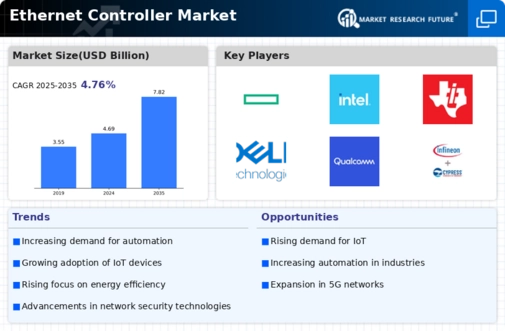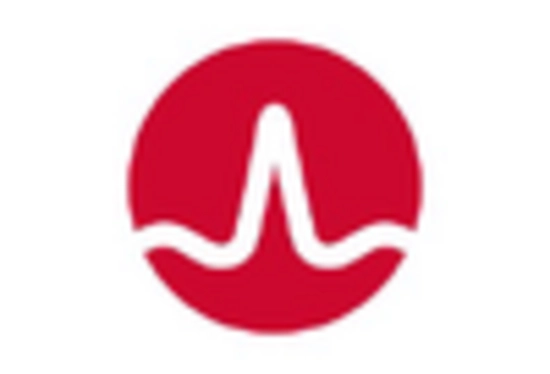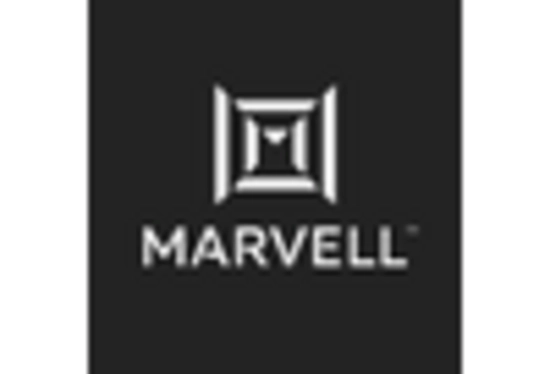Expansion of Data Centers
The Ethernet Controller Market is significantly influenced by the expansion of data centers worldwide. As the demand for data storage and processing capabilities increases, data centers are evolving to accommodate larger volumes of data traffic. Ethernet controllers play a crucial role in ensuring high-speed connectivity and efficient data transfer within these facilities. Recent statistics suggest that the data center market is expected to grow at a compound annual growth rate of approximately 10% through 2025. This growth is likely to drive the demand for advanced Ethernet controllers that can support higher bandwidth and lower latency. Consequently, the Ethernet Controller Market stands to benefit from this trend, as data centers increasingly rely on sophisticated networking solutions to enhance operational efficiency and meet the needs of their clients.
Emergence of 5G Technology
The advent of 5G technology is poised to have a profound impact on the Ethernet Controller Market. With its promise of ultra-fast data speeds and low latency, 5G is expected to revolutionize various sectors, including telecommunications, automotive, and healthcare. The deployment of 5G networks necessitates the use of advanced Ethernet controllers that can handle the increased data throughput and connectivity demands. As industries begin to leverage 5G capabilities, the need for Ethernet controllers that can support these high-performance requirements will likely surge. This trend suggests a significant opportunity for growth within the Ethernet Controller Market, as manufacturers develop innovative solutions to meet the evolving needs of 5G applications and services.
Increased Focus on Cybersecurity
The Ethernet Controller Market is increasingly influenced by the heightened focus on cybersecurity measures across various sectors. As cyber threats become more sophisticated, organizations are prioritizing secure networking solutions to protect sensitive data and maintain operational integrity. Ethernet controllers equipped with advanced security features are becoming essential components in safeguarding network infrastructure. The cybersecurity market is projected to grow significantly, with estimates suggesting a value of over 300 billion dollars by 2025. This growth indicates a rising awareness of the importance of secure communications, which in turn drives the demand for Ethernet controllers that can integrate robust security protocols. As businesses and institutions seek to fortify their networks against potential threats, the Ethernet Controller Market is likely to see increased investment in secure Ethernet solutions.
Growth of Smart Cities Initiatives
The Ethernet Controller Market is benefiting from the growth of smart cities initiatives across various regions. As urban areas increasingly adopt smart technologies to enhance infrastructure and improve quality of life, the demand for reliable and efficient networking solutions is rising. Ethernet controllers are integral to the functioning of smart city applications, such as traffic management, public safety, and energy management systems. Recent projections indicate that investments in smart city projects could exceed 2 trillion dollars by 2025. This influx of capital is likely to drive the demand for Ethernet controllers that can support the complex networking requirements of interconnected devices and systems. Consequently, the Ethernet Controller Market is positioned to capitalize on this trend, as municipalities seek to implement advanced technologies to create more sustainable and efficient urban environments.
Rising Adoption of Cloud Computing
The Ethernet Controller Market is experiencing a notable surge due to the increasing adoption of cloud computing solutions. As businesses migrate their operations to the cloud, the demand for high-performance Ethernet controllers has escalated. These controllers facilitate seamless data transfer and connectivity, which are essential for cloud-based applications. According to recent data, the cloud computing market is projected to reach a valuation of over 800 billion dollars by 2025, thereby driving the need for robust Ethernet solutions. This trend indicates that organizations are prioritizing efficient data management and connectivity, which in turn propels the growth of the Ethernet Controller Market. The integration of Ethernet controllers in cloud infrastructure enhances network performance, reliability, and scalability, making them indispensable for modern enterprises.

















Leave a Comment